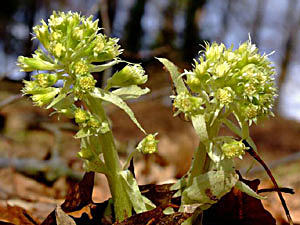
medicinal herbs
Butterbur
Petasites albus

Herb: Butterbur
Latin name: Petasites albus
Synonyms: Tussilago alba
Family: Compositae
Medicinal use of Butterbur:
The root is emmenagogue, hypnotic, sedative and vulnerary. The ground or finely chopped rhizome has a healing effect when applied to slow-healing or weak ulcers, or to suppurating wounds. An infusion of the leaves is a specific remedy for coughs. A homeopathic remedy is made from the roots. It is used in the treatment of wounds, ulcers etc.Description of the plant:

Plant:
Perennial
Height:
60 cm(2 feet)

Flowering:
Aprilto May
Habitat of the herb:
Waste ground, roadsides, plantations and woods, often in damp soils.Edible parts of Butterbur:
The small fleshy petioles (leaf stems) are very palatable when cooked and eaten like asparagus.Other uses of the herb:
A good ground cover for the wilder areas of the garden. It is too invasive to be used in small gardens and is only suitable for covering large areas. The leaves were at one time used by peasants as a head covering.Propagation of Butterbur:
Seed - we have no information on this species but suggest sowing the seed in a cold frame as soon as it is ripe or in early spring. Only just cover the seed and do not allow the compost to dry out. When they are large enough to handle, prick the seedlings out into individual pots and plant them out in the summer. Division succeeds at almost any time of the year. Very easy, larger divisions can be planted out direct into their permanent positions. We have found that it is better to pot up the smaller divisions and grow them on in light shade in a cold frame until they are well established before planting them out in late spring or early summer.Cultivation of the herb:
Waste ground, roadsides, plantations and woods, often in damp soils.Known hazards of Petasites albus:
None knownPlant information taken from the Plants For A Future.
